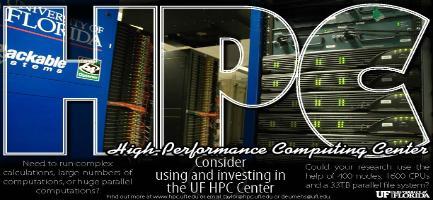After several years of planning, UFIT Research Computing (originally known as the HPC Center) first became operational at UF in August 2004 with Phase I of the HPC cluster. Researchers quickly embraced high-performance computing so the cluster has been upgraded and expanded several times since to keep up with changing technology and user demand.
For historical information about the development of UFIT Research Computing, Annual Reports are available from 2006.
COMPUTE CLUSTER HISTORY
| Phase | Date | Vendor | Mfgr Model | CPU Model | Core Count | Top 500 Score | HPL RMAX | HPL RPEAK |
| I | 2004 Q4 | Dell | PowerEdge 1750 | Intel Xeon 2.8 | 400 | 225 | 1,325 GFlops | 2,240 GFlops |
| IIa | 2005 Q4 | Rackable | C1001 | AMD Opteron 275 | 832 | 419 | 3,000 GFlops | 3,700 GFlops |
| IIb | 2006 Q4 | Rackable | C1001 | AMD Opteron 275 | 480 | N/A | ||
| III | 2008 Q3 | Penguin | Relion R1670SA | Intel Xeon E5462 2.8GHz | 896 | N/A | ||
| IV | 2011 Q1 | Dell | PowerEdge C6105 | AMD Opteron 4184 2.8GHz | 1,536 | N/A | ||
| HPG1 | 2013 Q2 | Dell | PowerEdge C6145 | AMD Opteron 6378 2.4GHz | 16,384 | 493 | 119,300 GFlops | 157,300 GFlops |
| HPG2 | 2015 Q4 | Dell | PowerEdge SOS6320 | Intel Xeon E5-2698v3 2.3GHz | 29,312 | 113 | 738,100 GFlops | 1,074,000 GFlops |
| HPG3 | 2021 Q1 | Lenovo | ThinkSystem SR645 | AMD EPYC 7702 2.0GHz | 30,720 | N/A | ||
| HPG3 | 2021 Q2 | Lenovo | ThinkSystem SR645 | AMD EPYC 75F3 3.0GHz | 9,600 | N/A |
GPU CLUSTER HISTORY
| Phase | Date | Vendor | Mfgr Model | CPU Model | Core/Card Count | Top 500 Score | HPL RMAX | HPL RPEAK |
| HPG2 | 2015 Q4 | Dell | PowerEdge R720 | nVidia Tesla K80 | 40 | N/A | ||
| HPG3 | 2019 Q2 | Exxact | Tyan S7109 | nVidia GeForce 2080TI | 96 | N/A | ||
| HPG3 | 2019 Q3 | Exxact | Tyan S7109 | nVidia GeForce 2080TI | 160 | N/A | ||
| HPG3 | 2019 Q4 | Exxact | Tyan S7109 | nVidia Quadro RTX 6000 | 48 | N/A | ||
| HPG3 | 2019 Q4 | Exxact | Tyan S7109 | nVidia GeForce 2080TI | 304 | N/A | ||
| HPG-AI | 2021 Q1 | nVidia | DGX A100 | nVidia Ampere A100 - 80GB | 1,120 | 22 | 17,200 TFlops | 21,314.7 TFlops |
HiPerGator 1.0
In 2011, development of a campus-wide available cluster was starting to come into shape. The UF HPC Center already had some investors from earlier years, and clusters in both the Physics Building and Electrical Engineering. However, it was time to consolidate the equipment and form a center that would be able to service all of campus, not just specific centers.
At the same time this was happening, the dean from IFAS (University of Florida Institute of Food and Agricultural Sciences) had visited Texas Advanced Computing Center and returned wanting to create an HPC Cluster in IFAS with some funding he had available. At first he went to ABE (Agricultural and Biological Engineering Department in IFAS) to see if it could be done there. ABE had already been working with the UF HPC Center for some work they were doing, and recognized that the investment that IFAS had to offer would be much smaller if used to create a separate cluster solely within IFAS due to infrastructure costs associated with space, power, cooling, and personnel. Instead, IFAS decided to invest the funds with the HPC Center in creating the first campus wide cluster that would eventually become HiPerGator 1.0, housed in the new data center off campus. This cluster would have additional matching funds from UF as a "bottom-up" or faculty-driven facility. It was also at this time that the UF HPC Center was incorporated into UFIT and renamed to become UFIT Research Computing.
The new East Campus facility opened in 2012, and HiPerGator 1.0 went into production in 2013, where it was operated until its retirement in 2021 after the installation of HiPerGator 3.0. HiPerGator 1.0 consisted of 256 Dell PowerEdge C6145 nodes with a total of 16,384 AMD Opteron cores. The cluster was ranked at number 493 on the Top 500 list of Supercomputers in the world in November of 2013.
HiPerGator 2.0
Working closely with Dell and Intel, Research Computing expanded HiPerGator by 30,000 processor cores and 1 petabyte of storage in 2016, bringing the cluster to a total of 51,000 cores and 3 petabytes of storage. As a result, HiPerGator stood as the third most powerful supercomputer among U.S. public universities at the time.
> Download video [MP4, 473 MB]
OTHER PROJECTS
UF Apps For Research (2013-2023)
While UFApps provides a Virtual Desktop Interface (VDI) service for students and faculty to easily access and work with a large number of applications, it is not designed for faculty and graduate students to carry out complex calculations. To meet that need, UFIT Research Computing ran a separate version of UFApps where complex computations could be carried out on large data sets.
UF Apps for Research ran on UFIT Research Computing systems for ten years from December of 2013 until July of 2023.
Knights Landing (2016-2019)
Two Knights Landing (KNL) machines were acquired from Intel for a pair of fellowships concerning Intel Code Modernization. The purpose of this project was to optimize code for the Intel Xeon Phi. This was a one-year appointment starting in August of 2016. Code was developed on the systems until their retirement early in 2019.
POSTERS

